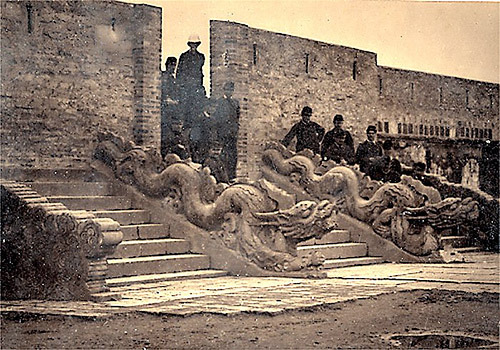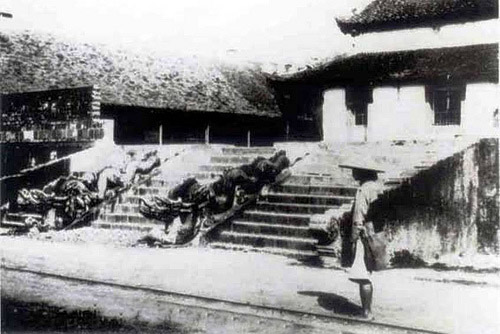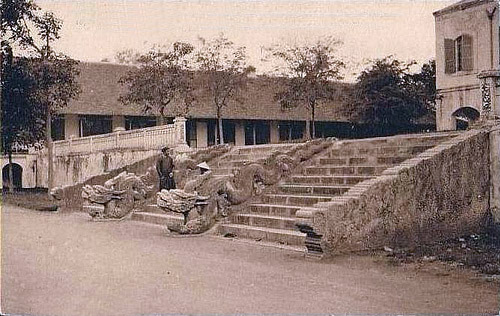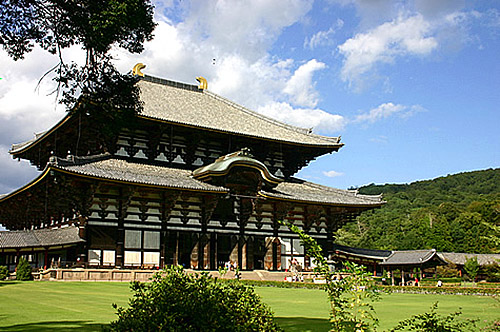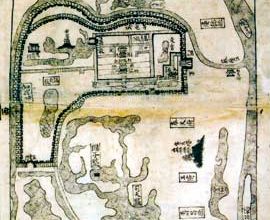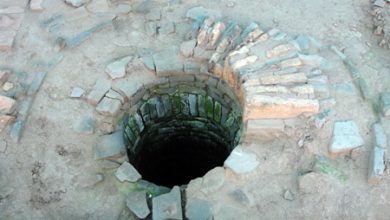Kinh Thien Palace
Kinh Thien Palace is the central area among the overall vestiges in Thang Long – Hanoi Imperial Citadel. It used to be a palace of great significance where the court held the most solemn rituals, welcomed foreign emissaries and gave audience to discuss affairs of state.
French soldiers taking photos on the steps of Kinh Thien Palace during the encamping period here. (Taken by Doctor Charles – Edouard Hocquard during 1884 -1885)
According to history
According to “The Complete History of Dai Viet”, Kinh Thien Palace started to be built in 1428 under the reign of King Le Thai To and completed under the reign of King Le Thanh Tong. It was built on the former foundation of Can Nguyen – Thien An Palace under Ly – Tran Dynasties in Nung Mountain.
King Ly Thai To named the Audience Palace Can Nguyen as the centre of the heaven and earth where he seated on the throne to rule the country. Succeeding Ly Dynasty, Tran and Le Dynasties continued to construct the the fortress system here. The area of great importance was Forbidden Palace (Dragon Palace or Dragon and Phoenix Palace) the centre of which was Can Nguyen and Thien An Palaces under Ly – Tran Dynasties and Kinh Thien Palace under Le Dynasty.
Since 1788, when King Quang Trung set up the capital in Phu Xuan – Hue followed by Nguyen Dynasty (1802 – 1945), Thang Long became the headquarter of Northern Citadel.
In 1805, King Gia Long ordered to build this area as the royal step-over palace for Nguyen Kings during their trips to the North. The name Hanoi Ancient Citadel originated in 1831 when King Minh Mang implemented an adminstrative reform in which provinces through out the country including Hanoi were established. Hanoi Citadel became the headquarters of Hanoi Province.
During French domination at the end of XIXth century, French colonialists destroyed Kinh Thien royal step-over palace and built a headquarters of artillery which was then called Dragon Courtyard (aka Long Tri) because there were stone dragons in the front and at the back.
After October 10th, 1954, when Vietnamese Army took over the capital, this area became the headquarters of the Ministry of Defence.
In 2004, the Ministry of Defence handed over a part of the centre of Thang Long – Hanoi Imperial Citadel to Hanoi People’s Committee.
Architecture
Kinh Thien Palace is the central monument and the core in the overall historic sites within Hanoi Ancient Citadel. Doan Mon (the Main Gate) and the Flag Tower of Hanoi are situated in the front of Kinh Thien Palace, Hau Lau (Princess’ Palace) and Cua Bac (Northern Gate) at the back, walls and smaller gates in the east and west. Along with some other relics in the ancient citadel, all these gates were classified as a historical monument by French Protective State in 1925.
Kinh Thien Palace was the central construction of the entire imperial palace under Le Dynasty (XVth – XVIIIth centuries) in Thang Long – Dong Kinh (Hanoi). In 1428, after defeating Ming Dynastry invaders, King Le Thai To continued to set up the capital in Thang Long, ordered to renew the damaged royal citadel. Kinh Thien Palace was built during this period of time. In 1886, it was destroyed. Nowadays, only ruins of steps and palace foundation remain (within the Hanoi Ancient Citadel).
In 1886, French soldiers built a two-storey building on the foundation of Kinh Thien Palace as the Headquarters of Artillery
Observing the architecture of Kinh Thien Palace in photographs taken by the French at the end of XIXth century, we can see that Kinh Thien Palace is a timber architecture with two “二” shape parts. The palace was built with the architecuture of 2 floors and 8 roofs with curved corners. The rooftop of the two storeys was sculpted with two dragons flanking to the sun. Around the palace, a large courtyard was surrounded with banisters.
Traces of KinhThienPalace are now only the old foundation. The foundation of the palace was 57m long, 41.5, wide and 2.3m high. The steps were built with granite and formed three entrances. In the south, the palace foundation still had handrail corridor of higher than 100 cm. In the front, the south of KinhThienPalace was the palace threshold built with large slates with 10 steps; the 4 stone dragons divided the steps into 3 alleys, forming the Royal Threshold. The steps were 13.7m long, 4.45m wide and 2.1m high with the two stone dragons carved in 1467 which were still relatively intact artifacts.
KinhThienPalace stone dragons were a masterpiece, representing the sculpture under early Le Dynasty. Carved with green rock, the dragons had raised big heads, round convex eyes, long horns, and mane gliding back. The dragon body formed many small curves, smaller toward the palace foundation; on the back, there was a long fin heaving like clouds or fire.
In the north of KinhThienPalace, there was another threshold of 7 steps, smaller than the main threshold in the south. The two sides of the threshold had two stone dragons dating King Le Trung Hung’s time (XVII century – XVIII century); the dragons were 3.4m long with 7 curves; the body had fin and scales; the feet had 5 claws, etc. The two sides of the handrails were decorated with lotus, waves, swords, fire and clouds, etc.
The foundation and threshold are meager relics of palace architecture under the Le Dynasty that remains to this day, partly reflecting the grand scale of Kinh Thien Palace in the past.
Nowadays, the space has become a “double” relic for the two eras, i.e. Kinh Thien Palace of Thang Long ancient imperial citadel and the Headquarter of General Commander of the Vietnam People’s Army – an important relic on modern Vietnamese history.
Since November, 2004, officially open to visitors, the ancient citadel – KinhThienPalace has become one of the sights extremely attractive to tourists.
Research for restoration of Kinh Thien Palace ambience
Many years ago, the restoration of Kinh Thien Palace was brought forward by scientists and Hanoi city leaders. However, because of the unfinished research and the incomplete documentation for proposing UNESCO to recoginize the centre of Thang Long Imperial Citadel as an International Cultural Heritage, the idea was not put into practice. Till now, after considering the people’s aspirations and with the support of researchers, the idea of restoring Kinh Thien Palace to help the residents have intimate feeling with the the appearance of ancient Thang Long has been mentioned again.
According to History Professor Phan Huy Le, Hanoi Municipal Authority also desires to restore Kinh Thien Palace, but the restoration of an ancient architecture satisfying scientific requirements, i.e.the adequacy of parameters and bases, is beyond our conditions. However, we can apply 3D technology to restore to the extent we can. We can demonstrate to visitors how the relics used to be, for example where a piece of bricks or decorations were placed, etc. Currently, this construction is being carried out by Institute of Archaeology and Japanese scientists.
Professor Le said that not many surface architectural constructions in Thang Long Imperial Citadel remained; under the ground, there were only traces of foundations, drains and wells overlaying on top of each other. KinhThienPalace had more traces because the palace foundation still remained and there was a photograph taken by the French. The photo was real, but it was taken under the Nguyen Dynasty, not KinhThienPalace in Forbidden Citadel in ancient Thang Long.
According to historical documents, in 1816 KinhThienPalace had collapsed and King Gia Long ordered to destroy it to rebuild the royal step-over palace. From the photo, it is difficult to restore the royal step-over palace; it is even harder to restore KinhThienPalace. It is necessary to carry out archaeological excavations around KinhThienPalace to understand it. In the coming time, it we can restore with 3D technology, then gradually restore in reality with the participation of experts, especially international experts.
Professor Le said that in the world there were two schools of reconstruction. The first was the East school, especially Japan. They wanted to carry out an extremely meticulous resurrection of relics with scientific bases as they did to the ancient capital of Nara. The second was the West school. They wanted to preserve the status quo of the relics. Vietnam should combine the beauty of these two schools. First of all, to preserve the original relics; if restored, first of all use 3D reconstruction technology; when possible, carry out the reconstruction in the reality.
According to Dr. Nguyen Van Son, Director of the Center for Thang Long – Hanoi Relics Preservation, the resurrection of the ancient architecture in the old capital in some countries has been carried out and highly appreciated by researchers such as the resurrection of Dai Kim Palace in Nara Ancient Capital in Japan or of the ancient capital in Korea.
Nara, the ancient capital of Japan
The restoration of KinhThienPalace is quite complicated, requiring the contributions of many specialties, wise and enthusiastic professors, researchers, historians. The research is not only based on traces of KinhThienPalace, i.e. the old foundation with stone steps but also documents and photos about this architecture. In addition, the archaeological excavations to reveal the building materials, the way to arrange the column footing, foundation of the old palace, etc. also play an extremely important role in the reconstruction process.
That is our desire; however, the reconstruction certainly can not be carried out right now but needs a route. Currently, the entire palace foundation remains; some relics relating to the palace architecture such as two handrails, the stone dragons in the front and at the back which are almost intact. Not only that, the image of Kinh Thien Palace under the Le Dynasty before 1886, i.e. before the French demolished the palace and built artillery house is stored in pretty good condition in archives.

